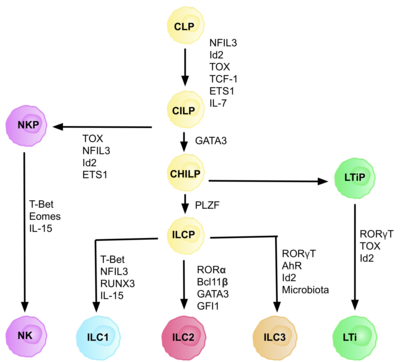ILC2

ILC2 cells, or type 2 innate lymphoid cells are a type of
The cell type was first described in 2001 as non-B/non-T cells, which produced IL-5 and IL-13 in response to
Parasitic infection
ILC2s play the crucial role of secreting type 2 cytokines in response to large extracellular parasites. They express characteristic
Respiratory virus infection
It has been observed, that ILC2s are activated upon respiratory virus infections in mice and humans. For instance, during
Allergy, atopic dermatitis, and asthma
ILC2s play a variety of roles in allergy.[19] Primarily, they provide a source of the type 2 cytokines that orchestrate the allergic immune response. They produce a profile of signals in response to pro-allergenic cytokines IL-25 and IL-33 that is similar to those produced in response to helminthic infection. Their contribution to this signaling appears to be comparable to that of T cells. In response to allergen exposure in the lungs, ILC2s produce IL-13, a necessary cytokine in the pathogenesis of allergic reactions. This response appears to be independent of T and B cells. Further, allergic responses that resemble asthma-like symptoms have been induced in mice that lack T and B cells using IL-33. It has also been found that ILC2s are present in higher concentrations in tissues where allergic symptoms are present, such as in the nasal polyps of patients with chronic rhinosinusitis and the skin from patients with atopic dermatitis.[20][21][22]
Barrier function
ILC2s are known to be enriched in the Fat-Associated Lymphoid Clusters (FALCs) within the
ILC2s are also known to be present in the FALCs within the pleural cavity. After being stimulated via IL-33 during an infection, they begin to secrete IL-5, leading to an activation of B1 B cells and the production of IgM antibodies.[25] ILC2s are the dominant population of ILC in the lungs. By producing IL-13, they can initiate smooth muscle contraction and mucus secretion, but also goblet cell hyperplasia if the IL-13 is overexpressed. In addition, ILC2s help pulmonary wound healing after influenza infection by secreting amphiregulin. Besides lungs, ILC2 populations can also be found in human nasal and tonsil tissues.[18]
Adipose tissue homeostasis
ILC2s are essential in the maintenance of homeostasis in lean and healthy adipose tissue. ILC2s resident in visceral adipose tissue produce IL-5, IL-13 and methionine-enkephalin peptides after prolonged exposure to
Research identified dysregulated responses of ILC2s in adipose tissue as a factor in the development of obesity in mice since ILC2s also play important role in energy homeostasis. Methionine-enkephalin peptides produced by ILC2s act directly on adipocytes to upregulate UCP1 and promote emergence of beige adipocytes in white adipose tissue.[26] Beige and brown adipose tissue are specialized in thermogenesis.[24] The process of beiging leads to increased energy expenditure and decreased adiposity.[26]
References
- PMID 30142344.
- PMID 22224763.
- PMID 30473412.
- PMID 21946417.
- PMID 32101749.
- S2CID 119093972.
- PMID 28718410.
- PMID 11754819.
- PMID 16606668.
- PMID 24876829.
- S2CID 4420895.
- PMID 20200518.
- PMID 20534524.
- PMID 27328009.
- PMID 23603794.
- ^ PMID 31930146.
- PMID 20200518.
- ^ PMID 29760695.
- ^ PMID 24613091.
- PMID 23363980.
- PMID 21461246.
- S2CID 21654970.
- PMID 30792718.
- ^ PMID 30792718.
- PMID 27582256.
- ^ PMID 25533952.
